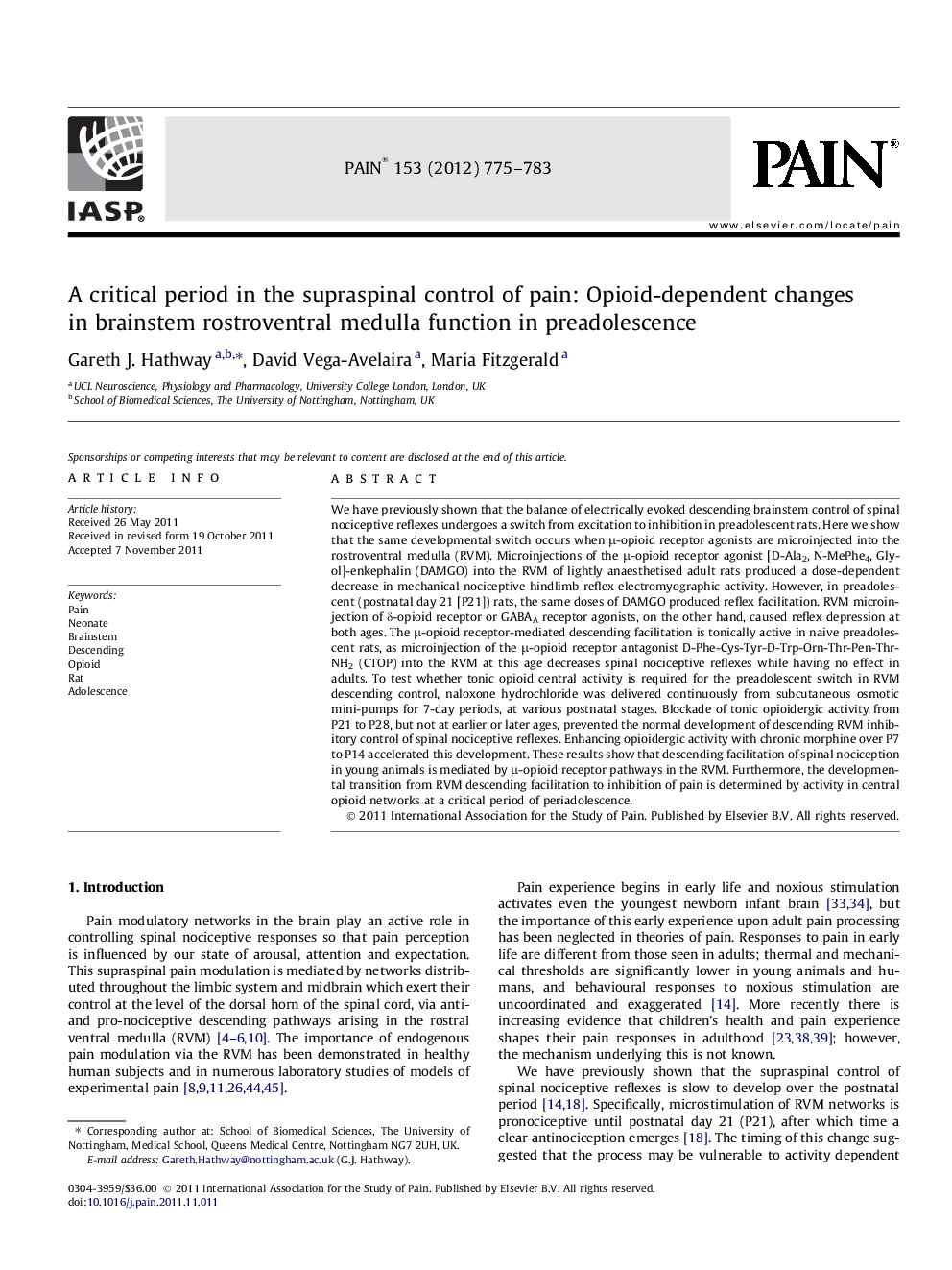| کد مقاله | کد نشریه | سال انتشار | مقاله انگلیسی | نسخه تمام متن |
|---|---|---|---|---|
| 10450886 | 918374 | 2012 | 9 صفحه PDF | دانلود رایگان |
عنوان انگلیسی مقاله ISI
A critical period in the supraspinal control of pain: opioid-dependent changes in brainstem rostroventral medulla function in preadolescence
دانلود مقاله + سفارش ترجمه
دانلود مقاله ISI انگلیسی
رایگان برای ایرانیان
کلمات کلیدی
موضوعات مرتبط
علوم زیستی و بیوفناوری
علم عصب شناسی
علوم اعصاب سلولی و مولکولی
پیش نمایش صفحه اول مقاله

چکیده انگلیسی
We have previously shown that the balance of electrically evoked descending brainstem control of spinal nociceptive reflexes undergoes a switch from excitation to inhibition in preadolescent rats. Here we show that the same developmental switch occurs when μ-opioid receptor agonists are microinjected into the rostroventral medulla (RVM). Microinjections of the μ-opioid receptor agonist [D-Ala2, N-MePhe4, Gly-ol]-enkephalin (DAMGO) into the RVM of lightly anaesthetised adult rats produced a dose-dependent decrease in mechanical nociceptive hindlimb reflex electromyographic activity. However, in preadolescent (postnatal day 21 [P21]) rats, the same doses of DAMGO produced reflex facilitation. RVM microinjection of δ-opioid receptor or GABAA receptor agonists, on the other hand, caused reflex depression at both ages. The μ-opioid receptor-mediated descending facilitation is tonically active in naive preadolescent rats, as microinjection of the μ-opioid receptor antagonist D-Phe-Cys-Tyr-D-Trp-Orn-Thr-Pen-Thr-NH2 (CTOP) into the RVM at this age decreases spinal nociceptive reflexes while having no effect in adults. To test whether tonic opioid central activity is required for the preadolescent switch in RVM descending control, naloxone hydrochloride was delivered continuously from subcutaneous osmotic mini-pumps for 7-day periods, at various postnatal stages. Blockade of tonic opioidergic activity from P21 to P28, but not at earlier or later ages, prevented the normal development of descending RVM inhibitory control of spinal nociceptive reflexes. Enhancing opioidergic activity with chronic morphine over P7 to P14 accelerated this development. These results show that descending facilitation of spinal nociception in young animals is mediated by μ-opioid receptor pathways in the RVM. Furthermore, the developmental transition from RVM descending facilitation to inhibition of pain is determined by activity in central opioid networks at a critical period of periadolescence.
ناشر
Database: Elsevier - ScienceDirect (ساینس دایرکت)
Journal: PAIN® - Volume 153, Issue 4, April 2012, Pages 775-783
Journal: PAIN® - Volume 153, Issue 4, April 2012, Pages 775-783
نویسندگان
Gareth J. Hathway, David Vega-Avelaira, Maria Fitzgerald,